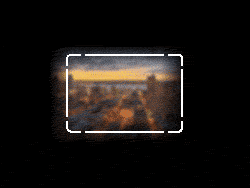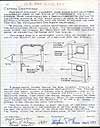Lensless-Optical Viewfinder
Hines Lensless Viewfinder
A bright, scratch-free optical viewfinder, usable in bright sunlight where LCD screens are washed out.
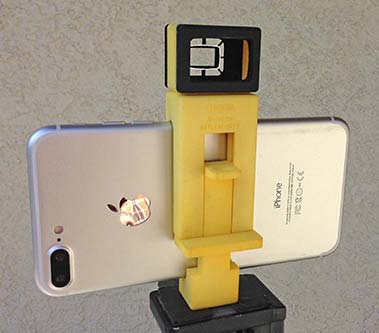 |
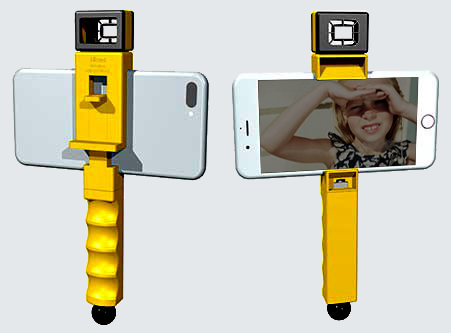 |
The Hines Lensless Viewfinder uses reflective optics to project a frame around the scene. A rim of spherical mirror focuses and projects the rectangular frame into the scene. Both optical elements are molded as part of the camera body, eliminating the usual viewfinder lenses.
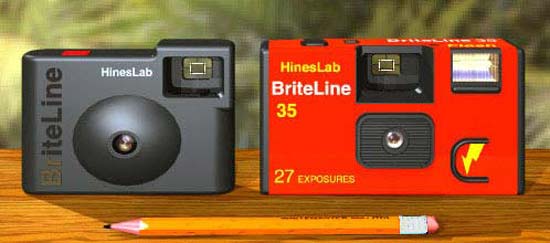
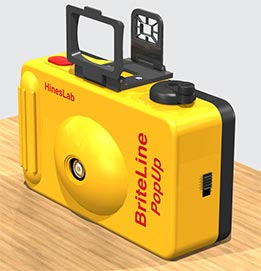 |
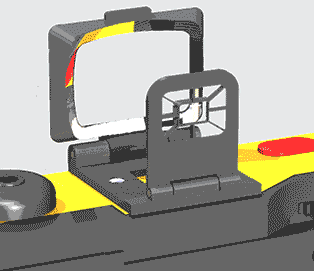 |
A pop-up version for sports cameras.
.
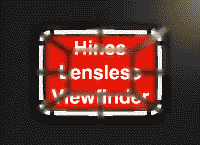 |
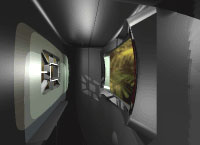 |
| As you approach the back of the viewfinder, the bright frame appears to be in the scene. The thin reticle is very close to the eye, and out of focus and unnoticed. | The interior shows the open rim of the concave spherical mirror on the camera’s front wall (right), facing the reticle on the back wall (left). |
Consumers make judgments about cameras quality based on the viewfinder. The unique Lensless Viewfinder sets the camera apart from the competition, lowers the manufacturing cost, and supports a higher selling price, for increased profit.
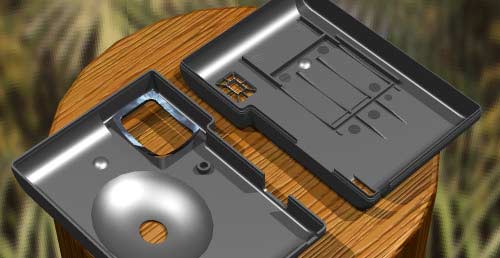
The spherically-curved rim around the front opening, and the reticle on the back wall, are flashed with aluminum to make them bright. The viewfinder is completed when the camera is assembled.
Hines Lensless Viewfinder
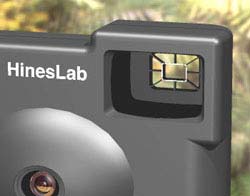 |
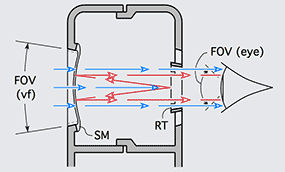 |
| The Hines viewfinder provides all of the advantages of the Albada finder with near the zero cost of an open-hole viewfinder. | Scene light (blue) passes through the open holes, and also illuminates the reticle in the back window and is then reflected (red) to the rim of spherical mirror where it is reflected and focused at the distance of the scene. |
|
The view through the viewfinder as the photographer moves around finding the center. The image of the scene is unaltered, big, bright and in focus because you are looking at it directly. The projected frame, which remains locked on the scene. |
Advantages: • Projected frame line shows the area being photographed. • Bright unaltered view of the scene. • No motion parallax between frame and scene.
|
Hines Lensless Optical Viewfinder:
Light from the scene passes directly through the front opening of the finder to illuminate the rectangular frame (the reticle) on the back wall. The photographer sees the reticle reflected in the rim of concave mirror around the front window.
On first using the Hines viewfinder, the reaction of most people is surprise to see a bright frame in the scene. It seems like magic.
*Note to optical engineers: Compare the 100% MTF of the scene viewed through the open-hole, to the degraded image of any other viewfinder. The Hines viewfinder adds the bright frame line without degrading the image of the scene.
– – – – – – – – – –
Comments about the Hines Lensless Optical Viewfinder:
“I have to say I always wanted to be someone like you. Your idea is brilliant!”, Dr. Filip Vaison La-Romanie, Texas, May 12, 2023.
“What a marvelous idea.” Lisa Davidson, lithographic printer, July 23, 2017.
“Love it.” Paul Ruben, former head of the Kodak Optical Engineering Dept., Rochester, New York, Aug. 13, 2016
“It seems like an utter no-brainer for all of the GoPro models without video panels”. Alisa Salaki, under-water photographer, Georgia, USA, July, 2016
“innovative… Easy to use: giving the same effect as a collimated optical system. The idea seems very clever, low cost, easy to manufacture, it could eventually be a product by itself… as an engineer I like brilliant ideas“. Alphonse Menudier: France, April 2013.
“The principle is so brilliant in its simplicity.” Antony Brown: Photographer, London, England, Sept. 2009.
“The reflective perimeter of the new viewfinder focuses the frame line; the scene, undiminished in size or quality, is viewed through an open hole” in the article “Skip the Lens”, in SPIE Magazine, May 2005.
“I just happened across this…. very slick!; best of luck w/commercializing it.“, Rick Oleson, Industrial Designer, Kentucky, USA, Oct. 2003.
“Not only does it aid the photographer by accurately delineating his field of view, but will be useful to any camera manufacturer who is trying to reduce the cost.” Paul Ruben: Optical engineer, former head of Eastman Kodak’s lens design dept., Rochester, New York, Dec. 2000.
“Extremely impressive. If I were working for a camera company, I would be very, very interested. Everyone should be. After seeing the models, I certainly prefer it over any Albada system.” Bill Ewald, Kodak Sr. Optical Engineer, lecturer at the University of Rochester (New York), Sept. 2000.
“… elegantly simple“, “a parallax free viewfinder that is impossible to degrade with finger print smudges“, “I tested it with glasses and it worked fine. Plenty of eye relief“, “… important and novel“… “It has the potential to become a new standard.“ Fred Bushroe: Optical engineer, Tucson, Arizona, April 2, 1999.
“I wish I’d thought of it.” Kodak Apparatus Division engineer. This was just one response in a presentation at Kodak, Dec. 5, 1997.
.
Albada Viewfinder (for comparison)
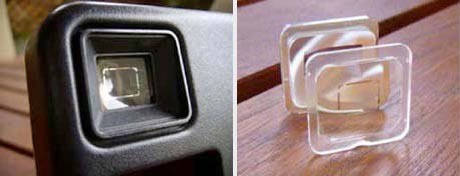 |
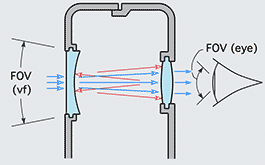 |
| The Albada viewfinder is an upgrade of a Galilean finder, and is too expensive for single-use cameras. A thin reticle of aluminum is deposited on the interior surface of the positive lens. The concave side of the front lens is partially aluminized to act as a magnifying mirror. | Scene light (blue) passes through the lenses which minify the image. Scene light also illuminates the reticle on the eye lens and is reflected (red) to the concave reflective portion of the front lens, which focuses and reflects it to the eye as being in the scene. |
|
The image is minified by the lenses. The position of the soft-focused front edge of the finder shifts with eye movement. Internal reflections between lenses can be distracting. The image distance in many Albada (and Galilean) viewfinders is focused uncomfortably close.
|
Advantages: • Projects a bright frame into the scene to indicate the field taken by the camera lens. • There is no motion parallax of the projected frame relative to the scene if the eye moves behind the finder. • Front window is approximately 15% smaller than open-hole finders. Disadvantages: • Cost of lenses and assembly. • Smaller image, making it hard to see. • Image is dim due to front-mirror coating. • Reflections and flare from uncoated lenses. • Simple 2-element design creates color fringes. • Lenses can become scratched or finger printed. |
Hines’ original lab notebook entry for this invention.
Consumers have not expected to find bright-frame viewfinders in single-use cameras, having seen only simple Galilean finders. The patented Hines Lensless Viewfinder provides the projected frame at near zero cost.
For further information:
• OE Magazine, May, 2005, p. 28
• Photo Imaging News, June 14, 2004, Vol. 21, No. 13, p. 6.
• Photo Marketing Association News, Oct. 2001, Vol. 77, No. 10.
• U.S. Patent 6,122,455 (includes zoom version)
HinesLab is actively seeking licensees to commercialize this technology. This is not a product being offered for sale to end users. Please contact Steve Hines at:
USA
ph. 818-507-5812
email: Steve@HinesLab.com


